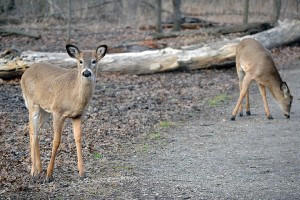Please don’t feed the animals

A white-tailed deer grazes on corn in Ojibway Park left behind by visitors to the park. Corn is actually not good for deer because it makes them feel full but doesn’t offer the nutrition they need (Photo by Rhiannon Lotze).
By Rhiannon Lotze
Converged Citizen Staff
Windsor and Essex County is home to an extensive deer population and some residents have been creating problems by feeding the deer, according to officials.
As herbivores, deer live on a diet of plants, fruits, acorns and nuts. They are well adapted to foraging for food, even in the winter. While it may not look like there is food for the animals in the colder months, deer adapt their diets to consist of twigs, fallen leaves and woody plants.
Because of this, they do not need to be fed by humans. However, many Windsorites have been putting out food which, at first glance, may not seem like a bad thing because it keeps the deer docile.
But, according to Tom Preney, a naturalist at Ojibway Park, the cons of feeding the animals far outweigh the pros.
“They’re getting used to humans and they’re relying on people for feeding,” said Preney, who has been working at the park for over ten years. “They’re crossing the roads more frequently to get to people’s backyards where they’re putting out the food. That makes the potential of hitting a car with a deer … you know, it’s not a good thing.”
According to Statistics Canada, thousands of accidents involving animals like deer and moose happen each year in Ontario alone. Feeding the deer not only entices them to cross roads to get the easily accessible food but it also acclimates them to humans so they are less afraid of oncoming vehicles.
Brent Hathaway, a Windsor resident, has seen the tame behaviour of the deer firsthand.
“(My dog and I) walk on the trails and we definitely see deer on the trails,” he said. Hathaway visits Ojibway Park to walk the paths about once a month. “They’re quite friendly. As long as I keep the dog away from the deer, they’ll come up to you. They’re quite tame.”
He also said he did not know feeding the deer could be detrimental.
According to Preney, the food is not only making the deer more dangerous to humans but it is also not the right kind of food.
“A lot of the stuff that people are feeding the deer is not good for them,” he said. “For example, people feed deer corn but what corn does is basically swell their stomach and they think that they’re full but they’re not getting the nutrition they need.”
Feeding the deer also aggravates the issue of overpopulation the Ojibway area has been experiencing for the last few years, said Preney.
Over the winter, Ojibway Park conducted its first population counts of deer in the area. They did two aerial surveys and found between 60 and 80 deer. Comparatively speaking, the ecologists at Point Pelee National Park recommend a deer population of about 30 deer for the 15 kilometer area of the park. The section of Ojibway surveyed is smaller but had more than twice a healthy deer population.
Because the deer in the area are being fed more food over the winter months than usual, they are surviving longer and the population is continuing to grow which could throw off the ecological balance in Ojibway.
The park is the last place prairies exist in Ontario and the deer population perpetuated by deer feeding puts its existence at risk, according to Preney.


